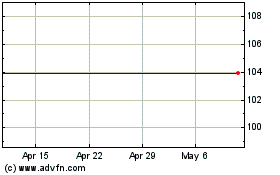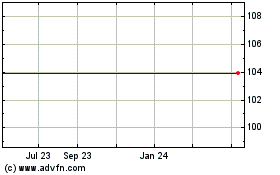Survey Finds Organizations Embracing Mobile Workstyles
March 06 2012 - 3:00AM
Business Wire
According to a survey of senior IT decision makers,
organizations across the globe are widely embracing mobile
workstyles as a way to empower business innovation. The Citrix
Global Workshifting Index, released today, indicates that by the
end of 2013 ninety three percent of organizations will have
implemented workshifting policies, up from 37 percent which
currently offer workshifting for part, or all, of their
workforce.
Mobile workstyles are enabled when people have access to the
technology and policies that allow them to be as productive when
they are outside the office – connected wirelessly using public
networks and often times personal devices – as they are in the
office using a company network and device. Workshifting is a type
of mobile workstyle in which work is moved to more optimal times,
locations and resources. For people, this means moving work to
a place where they find inspiration and can be their most
productive. For organizations, it means reducing business and IT
costs while providing flexibility to allow people to work anywhere,
anytime and on any device.
Survey respondents confirmed that organizations are recognizing
the benefits of mobile workstyles and workshifting including
improved business productivity and agility for the organization and
greater freedom, mobility and flexibility for users. They are
implementing workshifting policies to reduce business and IT costs,
provide greater workplace flexibility for people and improve
support for an increasingly remote and mobile workforce.
Workshifting Benefits Both the Organization and
People
Organizations are recognizing that giving people the ability to
work from anywhere can benefit both parties. The business reaps the
rewards of a highly mobile and agile business with increased
productivity and lower costs while people have the flexibility to
choose the ideal time, place and device for their work. According
to IT decision makers, the benefits of workshifting include:
- Giving people the flexibility to choose
the ideal time, place and device for their work. Seventy one
percent of respondents indicated that they are using workshifting
policies to enable people to work from anywhere and 63 percent to
enable people to work from home when required.
- Providing people with uninterrupted
access to desktops and apps during business disruptions of any
kind. Ninety four percent of senior IT decision makers agreed that
the need for comprehensive business continuity is very important
with 93 percent of those surveyed agreeing that desktop
virtualization was a very effective foundation for business
continuity.
- Reducing real-estate, travel and labor
costs through flex-work, telework and alternative workplace
strategies. Cost savings are among the main drivers for
workshifting with the reduction of HR-related costs at 45 percent,
improved ability to recruit workers in lower-cost regions at 39
percent, reduction of real estate costs at 38 percent and
contribution to environmental sustainability at 26 percent.
- Attracting and retaining the best
people through flex-work, telework and alternative workplace
strategies. Fifty one percent of IT decision makers indicated that
have implemented workshifting policies to help attract and retain
top talent. Nearly half of respondents also indicated that
workshifting enables organizations to tap into a broader labor pool
by facilitating collaboration with and among outsourcing partners,
contractors, business partners, temporary workers and
consultants.
Desktop Virtualization is Primary Enabling Technology for
Workshifting
Desktop virtualization is emerging as a key technology for
creating a more flexible workplace with 91 percent of organizations
planning to implement desktop virtualization by the end of 2013. Of
those implementing desktop virtualization, 57 percent indicated
they are implementing or will implement it to enable workshifting.
Desktop virtualization enables organizations to access full
desktops, applications and data from wherever they are, whenever
and from any device a worker chooses. In addition, the security
benefits of desktop virtualization ensure that confidential
business information is protected from loss and theft in order to
meet privacy and compliance standards. According to those surveyed,
92 percent of organizations have adopted or are adopting desktop
virtualization to improve information security. People can also
take advantage of online meetings and file-sharing services which
allow teams to collaborate effectively regardless of the location
of every individual.
Quote
Mick Hollison, vice president, Integrated Marketing &
Strategy, for Citrix
“Workshifting enables organizations to be more productive and
agile, and provides people with added mobility and flexibility to
move work to the most convenient and productive times, locations
and devices. We’ve long believed that workshifting is a key part of
a solid business and IT strategy and these survey findings are an
indicator that this trend is going mainstream. Organizations around
the globe are moving from traditional work environments and
realizing real-estate, travel and labor cost savings by enabling
mobile workstyles.”
Related Links
- Whitepaper: Workshifting: a global
market research report
- Whitepaper: The Top 10 Reasons to
Embrace Workshifting
- Whitepaper: Workshifting: How IT is
Changing the Way Business is Done
- Webpage: Workshifting Solutions
- Expert Blog: Flying Free: My First 30
Days as a Citrix Remote Employee
- Expert Blog: Do Ultrabooks Mean
Ultra-Productivity?
- Expert Blog: Change Brings
Security?
Follow Us Online
- Twitter: @Citrix, @XenDesktop,
@CitrixPR
- Citrix on Facebook
Sample size
The research for the Citrix Workshifting Index was conducted
independently by Vanson Bourne in October 2011, and is based on
1100 IT professionals across eleven countries. One hundred IT
professionals were surveyed in each of eleven countries including:
Australia, Brazil, Canada, China, France, Germany, India, Japan,
the Netherlands, the United Kingdom (UK) and the United States
(USA). Three quarters of respondents were from organizations of
1000 or more employees, one quarter were from organizations of
500-999 employees.
The research is based on the insights and experiences of 1,100
senior IT decision-makers from organizations of over 500 employees,
across 11 countries in North America, South America, Europe and
Asia.
About Citrix
Citrix Systems, Inc. (NASDAQ:CTXS) transforms how businesses and
IT work and people collaborate in the cloud era. With
market-leading cloud, collaboration, networking and virtualization
technologies, Citrix powers mobile workstyles and cloud services,
making complex enterprise IT simpler and more accessible for
260,000 organizations. Citrix products touch 75 percent of Internet
users each day and it partners with more than 10,000 companies in
100 countries. Annual revenue in 2011 was $2.21 billion. Learn more
at www.citrix.com.
For Citrix Investors
This release contains forward-looking statements which are made
pursuant to the safe harbor provisions of Section 27A of the
Securities Act of 1933 and of Section 21E of the Securities
Exchange Act of 1934. The forward-looking statements in this
release do not constitute guarantees of future performance. Those
statements involve a number of factors that could cause actual
results to differ materially, including risks associated with the
impact of the global economy and uncertainty in the IT spending
environment, revenue growth and recognition of revenue, products
and services, their development and distribution, product demand
and pipeline, economic and competitive factors, the Company’s key
strategic relationships, acquisition and related integration risks
as well as other risks detailed in the Company’s filings with the
Securities and Exchange Commission. Citrix assumes no obligation to
update any forward-looking information contained in this press
release or with respect to the announcements described herein.
The development, release and timing of any features or
functionality described for our products remains at our sole
discretion and is subject to change without notice or consultation.
The information provided is for informational purposes only and is
not a commitment, promise or legal obligation to deliver any
material, code or functionality and should not be relied upon in
making purchasing decisions or incorporated into any contract.
Citrix® is a trademark or registered trademark of Citrix
Systems, Inc. and/or one or more of its subsidiaries, and may be
registered in the U.S. Patent and Trademark Office and in other
countries. All other trademarks and registered trademarks are
property of their respective owners.
Citrix Systems (NASDAQ:CTXS)
Historical Stock Chart
From Jul 2024 to Jul 2024

Citrix Systems (NASDAQ:CTXS)
Historical Stock Chart
From Jul 2023 to Jul 2024
